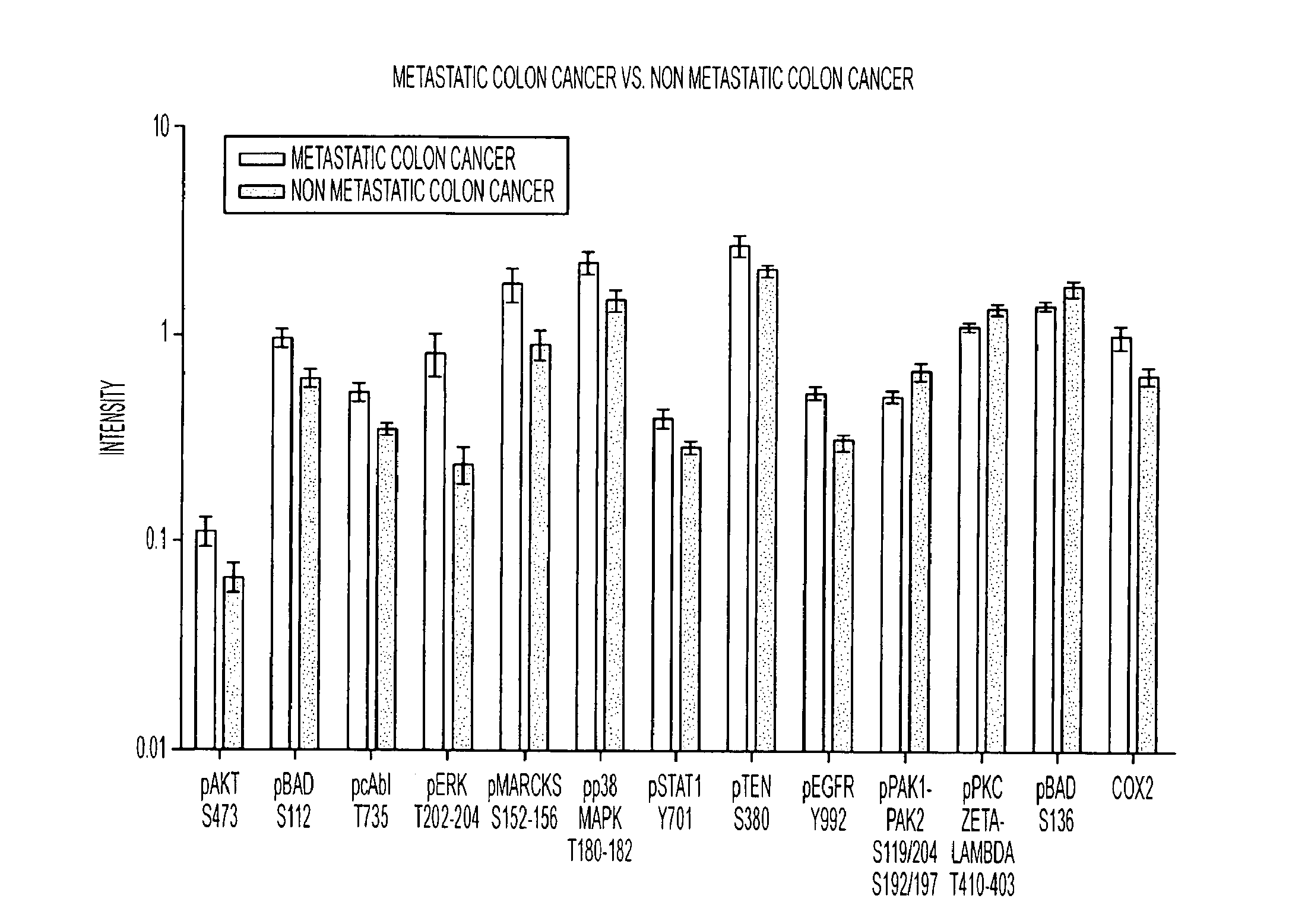Assay for Metastatic Colorectal Cancer
a colorectal cancer and metastatic technology, applied in the field of metastatic colorectal cancer assay, can solve the problems of complex analysis of many genes in gene expression analysis and endpoints that are limited to simple results
- Summary
- Abstract
- Description
- Claims
- Application Information
AI Technical Summary
Benefits of technology
Problems solved by technology
Method used
Image
Examples
example i
Materials and Methods
[0128]1. Reverse Phase Protein Microarrays. Microdissected cells, generated by previously published methods (e.g. Petricoin et al. (2005), J. Clin Oncol 23, 3614-3621; Liotta et al. (2003) Cancer Cell 3, 317-325; Sheehan et al. (2005) Mol Cell Proteomics 4, 346-365) were subjected to lysis and reverse phase protein microarrays were printed in duplicate with the whole cell protein lysates as described by Sheehan et al. (2005), supra. Briefly, the lysates were printed on glass backed nitrocellulose array slides (FAST Slides Whatman, Florham Park, N.J.) using a GMS 417 arrayer (Affymetrix, Santa Clara, Calif.) equipped with 500 μm pins. Each lysate was printed in a dilution curve representing neat, 1:2, 1:4, 1:8, 1:16 and negative control dilutions. The slides were stored with desiccant (Drierite, W. A. Hammond, Xenia, Ohio) at −20° C. prior to immunostaining.
[0129]2. Bioinformatics Method for Microarray Analysis.
[0130]Each array was scanned, spot intensity analyze...
example ii
Identification of Signal Pathway Alterations and Drug Targets that can Distinguish Colorectal Cancer that Metastasizes from Colorectal Cancer that does not
[0131]A study set was used of colorectal carcinoma that had presented with hepatic metastasis and colorectal carcinomas taken from human subjects at surgery that had no evidence of metastasis, and upon follow up, did not present with metastasis. The surgical samples were processed with laser capture microdissection and pure cancer cell populations were lysed and subjected to reverse phase protein microarray analysis. Using this technique, we were able to measure the phosphorylation state of 70 kinase substrates. Molecular network analysis was performed using commercially available software (Microvigene, VigeneTech, Mass.). Of the 70 phosphoendpoints analyzed, 12 were statistically significantly (via Student 1-test p<0.05) expressed between the metastatic (aggressive) vs non-metastatic (indolent) cancers. These results are shown in...
example iii
Studies in Animal Models of Colorectal Cancer Showing that an Inhibitor of a Target of the Invention can Inhibit Metastasis
[0137]Causal significance of the signaling activation status as an underpinning cause of the metastatic process and thereby a therapeutic target for prevention of future metastasis in patients that present with colorectal cancer without metastasis is tested in animal model systems.
[0138]In a first animal model system, the rat BDIX strain is injected with syngeneic colorectal DHD-K12 cell line cells into the splenic vein; the injected cells will quickly form liver metastasis in 15 days and lung metastasis in 20 days. The rats are pretreated with the following kinase inhibitors, either alone or in combination: an EGFR inhibitor; an AKT inhibitor; a COX-2 inhibitor; an ERK inhibitor; a p38 inhibitor; a PKC inhibitor; a cABL inhibitor; a STAT I inhibitor, using inhibitors as discussed herein.
[0139]In a second animal model system, the inhibitors are given concurrentl...
PUM
| Property | Measurement | Unit |
|---|---|---|
| thickness | aaaaa | aaaaa |
| resistance | aaaaa | aaaaa |
| frequency | aaaaa | aaaaa |
Abstract
Description
Claims
Application Information
 Login to View More
Login to View More - R&D
- Intellectual Property
- Life Sciences
- Materials
- Tech Scout
- Unparalleled Data Quality
- Higher Quality Content
- 60% Fewer Hallucinations
Browse by: Latest US Patents, China's latest patents, Technical Efficacy Thesaurus, Application Domain, Technology Topic, Popular Technical Reports.
© 2025 PatSnap. All rights reserved.Legal|Privacy policy|Modern Slavery Act Transparency Statement|Sitemap|About US| Contact US: help@patsnap.com


